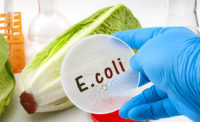Got It Covered
By Pamela Accetta Smith, associate editor
Suppliers of paints and coatings help meat and poultry processors keep their facility floors safe and clean.
Concrete is one of the most common building materials used in meat, poultry and prepared-foods processing facilities. That said — as is the nature of the beast — it is subject to a variety of extreme exposures, including rapid temperature changes during steam or hot-water washdowns, exposures to natural food acids, such as lactic, citric and acetic acids, frequent cleanings with caustic disinfectants, dampness from humidity, steam and condensation, contact with oils, dirt, grease, blood and foodstuffs, and constant traffic from feet, carts and forklifts.
To protect a plant’s concrete floors and walls from potential contaminants and corrosive agents, while enhancing its ability to withstand chemicals, it is crucial to select the appropriate protective flooring and wall system, says Gina Atzinger, food and beverage strategic account manager for Cleveland, Ohio-based Sherwin-Williams Industrial & Marine Coatings.
“This is best achieved by having an understanding of the properties of concrete, the operating environment and the conditions of installation and use,” she says.
As concrete is a porous substrate, moisture in the form of water vapor can migrate from below the slab to the area above the slab, depending upon the temperature, air movement and humidity.
“An impermeable protective coating applied to the concrete not only prevents the migration of chemicals in and through the concrete, it also prevents any moisture from traveling out of the concrete,” says Atzinger. “Although moisture vapor alone does not have the force necessary to disbond a resinous flooring system from concrete, ions contained within the slab to the surface can, throughseveral chemical processes, force the system to blister.”
To serve the unique needs of this market, Sherwin-Williams Industrial & Marine Coatings offers environmentally friendly coatings solutions that are engineered to meet all of the needs of USDA-inspected meat, poultry and prepared-foods processing plants — floor to ceiling, front office to tank interiors.
“Engineered for long-term performance and a return to service within two to three hours after installation, Sherwin-Williams’ FasTop™ Flooring Systems are more effective than epoxy in addressing the challenges posed by thermal shock and wet environments,” says Atzinger. “The water-based urethane cement technology offers seamless, low-odor and easy-to-clean floor systems that are resistant to thermal shock, impact and moisture.” Reducing costly downtime for the food industry without sacrificing quality, these systems can be applied to newly placed or properly prepared, aged and/or contaminated concrete.
“These systems offer superior resistance to the most common chemical exposures in food-processing operations,” says Atzinger. The company’s 4844 PAce-Cote Polyaspartic floor coating technology provides superior chemical and temperature resistance, as well as color retention and UV stability.
“It cures rapidly even in low temperatures, and resists hot oils, grease and steam cleaning,” says Atzinger. “It is a tough but flexible coating that also can be returned to service in two to three hours after installation. The Sanifiber wall-ceiling system is a unique fiber-reinforced, water-based epoxy resin system that provides UV resistance not typical of epoxy based systems, as well as superior chemical and impact resistance.”
For steel substrates, Sherwin-Williams’ FastClad DTM (Direct to Metal) polyaspartic urethane offers a wide range of benefits for everyday maintenance challenges, says Atzinger.
“It dries quickly, which reduces downtime and provides performance equal to that of a two-coat epoxy-urethane in one coat,” she says. “It also provides high-performance protection with excellent gloss and color retention.”
Addressing the issues
With the many issues concerning pathogens, there are several additives available to coating manufacturers which will inhibit any bacterial growth, says Gary O’Connor, manager of composites and resin technologies for Montgomeryville, Pa.-based ITW Polymer Technologies.
“At ITW, our products are formulated as such that they do not support bacterial growth, and our success has proven this over the years.”
Thermal shock is a large concern in any meat-processing facility, as the cleaning substantially requires high-pressure hot water over cold substrates.
“Often times, this creates a stress that will lift many coatings not able to withstand these conditions,” says O’Connor. “The ITW Impax 5020 is a resin-rich, aggregate-filled resurfacing epoxy where the aggregate acts as a heat-sink and enables the coating to withstand such conditions.”
Safety is another area of concern for meat and poultry processors. To that end, says, O’Connor, slips and falls are a major liability for any company, especially where wet conditions and residual fat, for example, provide opportunities for accidents. Anti-slip coatings are also used on ramps and docks to provide traction for forklift traffic. ITW offers a complete line of slide-free coatings formulated with Kevlar® and aluminum oxide.
“And, as our Impax 5020 wears, it maintains its anti-slip finish. What’s more, the tenacious bond quality of this epoxy lessens the likelihood of a repair.”
Most of the company’s products, says O’Connor, are solvent-free formulations that have little or no odor.
“Processors must be careful that floor-coating solvents do not absorb into the food products,” he says. “The Impax 5020 is virtually odor-free when compared to other generic products.”
For manufacturing areas consisting of clean-in-place (CIP) cleaners and acids, the ITW Impax 5020AR is an excellent acid-resistant resurfacing epoxy formulated with tightly cross-linking Novalac epoxy.
“This system is also ideal for battery storage areas for forklifts,” he says.
System selection
Selecting the resin system chemistry appropriate to guard against the corrosive conditions present in a food plant requires an analysis of the specific chemicals potentially in contact with the flooring system and wall surfaces. This includes testing for combinations of chemicals that may, together, be exposed to the surface.
Next, physical considerations must be addressed, says Atzinger.
“Surface thickness will be driven by the need to provide thermal-shock protection, resurfacing requirements and the traffic conditions expected,” she says. “In general, chemical resistant systems are resin rich and utilize aggregate to build thickness, decrease the Coefficient of Linear Thermal Expansion (CLTE) of the system, and provide abrasion resistance where required.”
Food-processing plants also have the added element of live steam and/or very hot water in the cleaning process.
“Here, additional analysis of the system’s CLTE and the flexibility of the bond interface to concrete is required,” says Atzinger. Some resinous flooring will expand at 10 times the rate of concrete or steel. This is also true of resinous coatings on a block or concrete wall.
“System failure will result in blistering and disbondment,” says Atzinger. “Utilizing FasTop flooring systems with a CLTE closer to that of the concrete will minimize the detrimental effects of this kind of treatment, and provide a life expectancy that far exceeds traditional epoxies in similar environments. Wall systems can also be constructed using flexible epoxies.”
East Hartford, Conn.-based Dur-A-Flex Inc. offers a wide variety of floor and wall systems that hold up to high traffic and address compliance requirements. The company’s acrylic, epoxy and urethane floor and wall systems offer the flexibility needed to deliver lasting value, says Steven John Lipman, urethane product manager for Dur-A-Flex.
Although the technology behind cementitious polyurethane-based flooring has been around for more than 35 years, says Lipman, restrictive patents and reduced availability have meant only a small network of installers were able to offer the product at a high-end price.
“Through fundamental improvements and modern advances in resin formulation and extensive development over the past 15 years, cementitious polyurethane technology has been able to formulate systems with a high-resin content and low viscosity that both flow and level better,” he says. “This has enabled the origination of heavy-duty flooring compounds that have zero volatile organic components, are highly chemical resistant and non-porous, and are now able to be installed more efficiently and effectively.”
With an excellent track record, these improvements have opened opportunities for installers to offer a cost-effective and superior alternative to originally specified acid brick, quarry tile and other resin-based flooring systems in industrial food-processing applications.
In meat processing, wide temperature variations in a relatively short period, such as hot water discharge from equipment or from steam cleaning, can have an adverse effect on adhesion of synthetic flooring materials, says Lipman.
“The coefficient of thermal expansion should be as close as possible to the coefficient of expansion of the concrete to avoid the stresses from linear deformation, affecting the bond strength to the concrete,” he says. “Cementitious urethane systems possess a similar modulus of elasticity to that of concrete, which virtually eliminates differential flexing that occurs with most other resins.”
In cold range of temperature transition, relatively rigid epoxies become even more brittle and strained, reducing their ability to withstand mechanical loads.
The modules of elasticity of cementitious urethane systems hardly change under the effect of temperature, says Lipman. This means, he says, that there are no unwanted stresses that may lead to accelerated wearing.
Today, industry and commerce floor coatings must provide an impermeable seal with chemical resistance appropriate for the individual application, says Lipman. Government agencies require an impermeable floor system in the event of an accident and contamination of ground water.
“Coatings are required to not only protect concrete from the effects of harmful substances, but also mechanical stress; any softening of the coating due to chemical exposure would not be a problem without additional mechanical loads, but [it] becomes a serious wear factor as a result of additional trafficking,” says Lipman. “Cementitious polyurethane systems’ complex cross-linking gives unparalleled resistance to a broad range of chemicals including organic and inorganic acids, solvents and alkalis. Swelling — normally the start of chemical destruction — is very much restricted. And if damage does occur, it only works slowly through the coating.”
Very low odor and zero risk of taint to open food products in close proximity allows cementitious urethane systems to be successfully installed in meat-processing areas were epoxy or MMA would require tenting of the area and routing of fumes with fans and ducting, says Lipman.
“Testing with these products in both component format and during cure in an airtight testing room in the presence of sensitive food items has proven that there is no transfer of taint,” he says. “The abrasion resistance of the cementitious urethane systems is also very high, with results comparable to that of the two component aliphatic chemically resistant urethanes that are often used for hanger floors. Exceptional Taber Abrasion results are also realized, particularly when compared to the results of an epoxy coating.”
Cementitious polyurethane systems, in addition to being able to absorb and dissipate heat and cold, also have excellent sound-deadening properties, particularly in areas where the operation requires traffic with steel wheels.
“Another benefit is the very consistent, low gloss that is achieved with these systems,” says Lipman. “Many architects and designers are specifying low-gloss finishes especially in processes that are affected by gloss reflection. The matting effect is not done by a suspended particle, but is the result of one of the chemical reactions. This results in uniform, low-gloss readings throughout the whole structure of the system. Also, the impact resistance of these floors causes the floor to deform rather than crack by distributing the impact [load] throughout the system, unlike quarry tile and acid brick and other systems.”
Recommended for applications where wet processing or high-temperature cleaning is carried out, Dur-A-Flex has engineered polyurethane resin floor systems specifically for food and pharmaceutical industries with a range of products offering hygienic and chemical resistance. The company’s Poly-Crete™ polyurethane products have been developed and manufactured in the United States to meet the challenges and demands of today’s individual process requirements. Dur-A-Flex’s Poly-Crete MD is formulated to withstand aggressive thermal and chemical attacks, resist abrasion, and be easy to maintain.
“It is engineered to protect concrete, polymer-reinforced screeds and plywood from chemical attack and corrosion,” says Lipman. “It is also favorable for food and chemical processing areas, manufacturing plants, cook/chill areas and commercial kitchen facilities.”
As an added value, Dur-A-Flex recognizes the need to be at the forefront in developing eco-friendly products. That said, all Poly-Crete systems are Zero VOC rated.


Report Abusive Comment